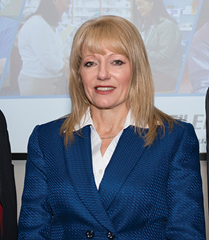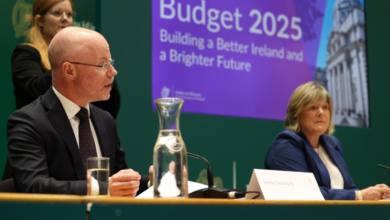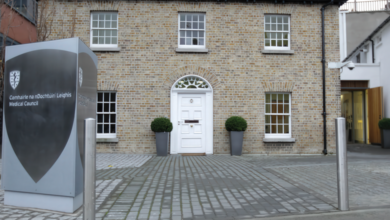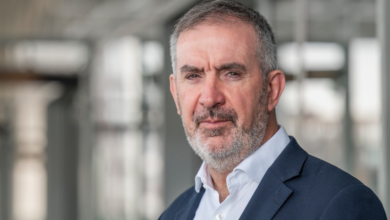Managing health in lean times
 Laverne McGuinness, the HSE’s National Director for Integrated Services, tells an eolas seminar how reform is improving services on the ground, even when demand is rising and resources are decreasing.
Laverne McGuinness, the HSE’s National Director for Integrated Services, tells an eolas seminar how reform is improving services on the ground, even when demand is rising and resources are decreasing.
In a time of considerable change, the Health Service is making real progress in administering and delivering care in a more efficient way. However, major challenges remain as the system faces further staff and budget reductions.
Laverne McGuinness, the National Director for Integrated Services at the Health Service Executive, explained how the service was managing “in lean times” when speaking at an eolas seminar on the future of health services.
For all staff and managers, she said: “The core objective is to deliver the absolute maximum amount of safe patient and client care that we possibly can, with the amount of money that we have available to us.”
As is widely recognised, the key challenge is to deliver more for less. Demand for services is increasing but the budget is decreasing. Gross expenditure on health rose from €7 billion in 2001 to €15.5 billion in 2009, before falling to just over €12.2 billion for 2012. It is likely that this will be reduced by another €750 million in 2013.
Staffing levels went up from 90,302 in 2001 to a peak of 112,771 in 2007. The workforce has been reduced by 10,935 staff since 2007. Almost 5,000 redundancies took place in February 2012, under the public sector wide redundancy programme. Under HSE targets, workforce numbers are due to fall by another 3,400 in 2013 and fall further to 95,500 by 2015. “It’s not just ‘back office admin’ staff that will be affected but “some of this reduction will affect front-line staff,” she explained.
Providing services with this smaller workforce will be “a huge challenge because people’s need for services won’t go away.” McGuinness added: “There are significant advances in medicine and public expectations are high, so we need to continuously strive to see how we’re going to deliver the maximum amount of services for the money that we have.”
Dealing with this challenge involves major changes in work practices which are supported by the Public Service (or Croke Park) Agreement, which enables staff to work as flexibly as possible.
McGuinness stated: “If you always do what you always did, you’ll always get the same result, so we’re driving very significant change and reform particularly through our national clinical programmes, be that in hospitals, mental health services, disability services and, of course, through the Government’s reform agenda.”
Increased demand for services is, first and foremost, driven by a growing population. There has been an 8 per cent increase in the population since 2006, taking it to 4.59 million.
Ireland also has the highest birth rate in the European Union, with around 74,000 births per year. This is coupled with the number of people over 65 increasing by approximately 20,000 each year. As a result, the number of people with age-related illnesses is expected to rise by 40 per cent by 2020. This, in turn, will increase the demand for and cost of certain drugs and other services. For example, cancer drugs have a “huge cost” but also add significantly to the quality of life and life expectancy of patients.
The weaker economy also has a “knock-on effect” with more people qualifying for medical cards as they become unemployed or their income falls. The number of medical cards has increased by 58 per cent since 2005. This increase is due largely to greater numbers of applicants becoming eligible as a result of rising unemployment.
HSE statistics also show that hospital activity is increasing, but so too is productivity. The increase in people going to emergency departments (an extra 38,945 over one year) is “quite worrying” though thankfully the increase in actual admissions to hospital (7,091) is much smaller. A major focus for the HSE is to encourage people to go directly to their GP, rather than going to the emergency department, where this is more appropriate.
In the HSE’s community services, particularly for older persons, the Fair Deal scheme is “highly costly” but it does allow people to receive appropriate long-term residential care, irrespective of their income.
Changing the workforce
The Croke Park Agreement has enabled changes that would previously have been impossible or very difficult to achieve.
Before Croke Park, the HSE had to go through a "huge negotiation process" with unions. “It could take months and you might not be guaranteed to get the change. However, with the Croke Park Agreement, we have great flexibility.”
For example, over 4,500 staff have been re-assigned to more critical areas of work under the agreement. “That does not mean just moving from one office to another,” McGuinness stated. “Staff are now expected to transfer or to be re-assigned, up to 45 kilometres each way,” where required, without compensation. She acknowledges that this does mean some personal difficulty for staff but it is necessary to rationalise services.
The agreement also allows for a combining of roles. This, however, does not mean “double-jobbing” but rather a “consolidation” of services. She stated that this would not have been possible before Croke Park. One example of this is community nursing units where previously in some places, each community unit had a Director of Nursing in charge. However, through Croke Park, the HSE has been able to re-organise the workforce so that in some cases one Director oversees two units. “Everybody is taking on additional responsibility.”
In terms of providing services to patients, 8am to 8pm has now become the normal working day for clinicians, rather than the 9am to 5pm which previously had been the norm. McGuinness remarked that, as the busiest times are around 8am and between 6pm and 8pm, the extended working day is of great benefit to patients and, in addition, it is no longer necessary to pay overtime payments at these times when staff are most needed.
Through the ‘Vision for Change’ reform programme in mental health, Ireland has moved from having one of Europe’s highest rates of institutionalised care, to providing a large range of services in the community. The provision of these services in the community adds significantly to the quality of life for the clients of these services. “It is a huge change for psychiatric nursing staff and they have risen to the challenge,” she stated.
There are approximately 1.8 million medical card holders in the country and one example of change has been the number of staff processing medical cards. This has been reduced from 450 to 150 following the transfer of processing to one site in Finglas.
There is also “a hugely significant cost reduction programme going on right across the country,” McGuinness continued. The aim is to protect front-line services by cutting as much money as possible in administration and in areas that will not impact on front-line services. Small examples of this mean that HSE staff, as a rule, now publish documents online rather than printing them. A lot of training takes place on the web rather than travelling to training courses. Any foreign travel, which is only authorised on a very exceptional basis, has to be officially approved at national level. She affirmed: “It behoves us all to do exactly what we can to trim back on everything else that’s there, before we actually touch or reduce front-line services.”
Clinical efficiency
Some of the HSE’s recent success stories have come from its clinical reform programmes, which are driving extra efficiency across the health system.
Access to beds in hospitals is a key requirement but long stays in hospital mean that new patients find it hard to enter the system. Hospital stays of up to 10 or 11 days were once common but this has now been brought down to 5.8 days. “Reducing the amount of time that somebody spends in hospital means we are freeing up beds so that more people can get access to the services they need,” McGuinness said. “We are at the same time reducing our costs.”
For the first nine months of 2012, there were 623,550 day case procedures treated in the country’s hospitals. Carrying out surgery on a ‘day case’ basis is cheaper than keeping patients in hospital as in-patients. In 2012, the HSE set a target of 75 per cent of procedures to be carried out as day cases. This target was exceeded and the day case rate reached 76 per cent.
Of the patients who require surgery on an in-patient basis, the aim is to admit them on the day of surgery. This means that instead of bringing patients in the day before their procedure, they would arrive on the day itself. The proportion of surgery carried on out on the day of admission has improved by 10.2 per cent to 54 per cent. However, the target is 70 per cent and this shows there is still “a road to go on.”
Colon cancer and rectal cancer are “very prevalent” in Irish society and the death of cancer patient Susie Long in 2007 highlighted the risks of delayed treatment. The case prompted major changes.
“When there is an urgent referral letter [for a colonoscopy] from the GP, every hospital has to have that carried out within a period of 28 days and there is zero tolerance,” McGuinness reported.
This is monitored at the highest level in the organisation.
“We know if there is a breach and if there is a breach, they have to be dealt with in a couple of days.” In relation to urgent breast cancer cases, 99.7 per cent are now seen by a consultant within two weeks.
9,000 to 0: a case study in cutting waiting lists
The number of patients waiting for nine months or more at a Galway hospital fell from around 9,000 to zero between January and September of last year. The success was initiated by the Health Minister James Reilly who established the Special Delivery Unit, one aim of which is to reduce the number of people on waiting lists and that ultimately, no one should be waiting for more than nine months.
In addition, the other objectives of the Special Delivery Unit are the reduction in the numbers of people waiting on trolleys in emergency departments and in the length of time that they have to wait. This is in line with the Minister’s focus on ensuring greater dignity and respect for patients. Significant improvements have been made in emergency departments across the country and when compared to last year, 16,700 fewer people are now waiting on trolleys, which is a 26 per cent reduction. Even with these successes, the HSE is “still striving to do more.”
Budget mostly spent outside hospitals
Many people associate health spending with hospitals but they take up 28 per cent of the health budget. This is still a considerable sum: €3.5 billion.
Primary care re-imbursement services (PCRS) i.e. the spend on medical cards and costly medication, is the second largest item, accounting for €2.5 billion.
Another €4.5 billion is allocated for services to older people, people with disabilities, mental health services, children’s and primary care services.
A further €1.7 billion goes on other services, including ambulances, public health, social inclusion and palliative care, and on areas that are not normally associated with health e.g. testing public water systems, and inspection of tobacco control in hotels and restaurants.






